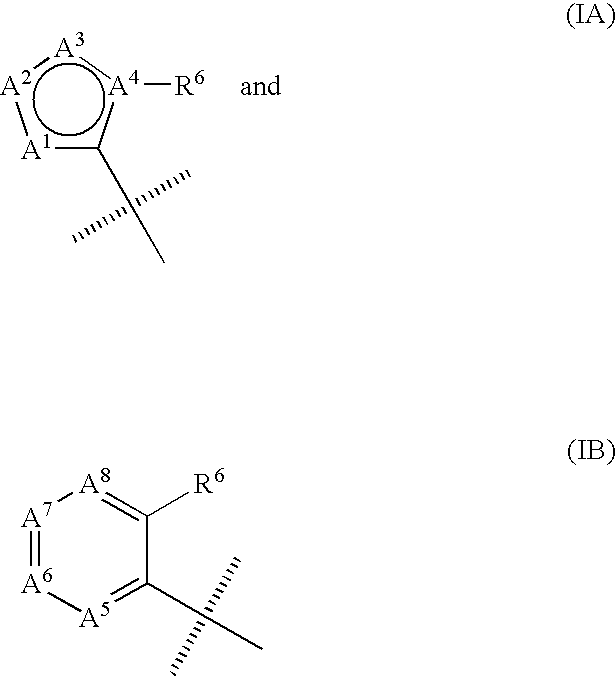Tachykinin receptor antagonists
a technology of tachykinin receptor and antagonist, which is applied in the field of peptides, can solve the problems of ineffective treatment of chemotherapy-induced nausea and emesis, ineffective management of delayed emesis, and numerous side effects of ssris
- Summary
- Abstract
- Description
- Claims
- Application Information
AI Technical Summary
Benefits of technology
Problems solved by technology
Method used
Image
Examples
preparation 14
(2-methoxy-5-trifluoromethoxy-phenyl)-methanol
[0182]Dissolve 2-methoxy-5-trifluoromethoxy-benzaldehyde (9.0 g, 40.9 mmol) in MeOH (100 mL) and treat with sodium borohydride (1.45 g, 38.3 mmol). Stir at RT for 1 h., then carefully quench with 1N HCl to pH 3. Concentrate, then extract the aqueous mixture with CH2Cl2 (3×100 mL). Combine the organic phases and wash with saturated NaHCO3 (100 mL) and brine (100 mL). Dry the organic layer, then filter, and concentrate. Purify the crude material by flash chromatography using a linear gradient of 100% hexanes to 40% EtOAc / hexanes to give (2-methoxy-5-trifluoromethoxy-phenyl)-methanol (6.86 g, 75%) as a colorless oil. 1H NMR (400 MHz, CDCl3) δ 7.19 (m, 1H), 7.10 (dd, 1H, J=2.9, 8.8 Hz), 6.83 (d, 1H, J=8.8 Hz), 4.66 (d, 2H, J=6.4 Hz), 3.85 (s, 3H), 2.21 (t, 1H, J=6.4 Hz).
preparation 15
2-Azidomethyl-1-methoxy-4-trifluoromethoxy-benzene
[0183]Dissolve (2-methoxy-5-trifluoromethoxy-phenyl)-methanol (4.49 g, 20.2 mmol) in DMF (40 mL) and treat with thionyl chloride (1.65 g, 22.6 mmol). Stir at RT for 2 h, then treat with potassium carbonate (5.57 g, 40.3 mmol), sodium azide (2.35 g, 36.1 mmol), and DMSO (40 mL). Stir the resulting mixture at RT overnight, then pour into water (100 mL) and extract with ether (3×100 mL). Combine the organic phases and wash with water (2×100 mL) and brine (100 mL). Dry the organic layer (MgSO4), filter, and concentrate to give the title compound (4.77 g, 96%) as a colorless oil that may be used without further purification. 1H NMR (400 MHz, CDCl3) δ 7.14 (m, 2H), 6.87 (m, 1H), 4.34 (s, 2H), 3.85 (s, 3H).
preparation 16
3-Oxo-3-pyrimidin-5-yl-propionic acid methyl ester
[0184]Add a 25 wt % solution of sodium methoxide in methanol (4.5 mL, 19.8 mmol) to toluene (40 mL) and heat to 85° C. under N2. Dissolve pyrimidine-5-carboxylic acid ethyl ester (2.0 g, 13.2 mmol) in EtOAc (2.1 mL) and add dropwise to the toluene solution. Heat the reaction mixture for 1 h, then add a suspension of sodium methoxide (715 mg, 13.2 mmol) in EtOAc (15 mL) dropwise. Heat the reaction mixture at 85° C. overnight, then cool to RT and pour into a solution of glacial acetic acid (12 mL) and water. (50 mL). After stirring for 1 h at RT, extract with EtOAc (3×100 mL). Wash the organic phase with brine (200 mL), dry over sodium sulfate, filter, and concentrate under reduced pressure to give the title compound as a mixture of tautomers: 1H NMR (300 MHz, CDCl3) enol form δ 12.43 (s, 1H), 9.26 (s, 1H), 9.10 (s, 2H), 5.76 (s, 1H), 3.86 (s, 3H); keto form δ 9.42 (s, 1H), 9.30 (s, 2H), 4.06 (s, 3H), 3.74 (s, 2H).
PUM
| Property | Measurement | Unit |
|---|---|---|
| temperatures | aaaaa | aaaaa |
| temperatures | aaaaa | aaaaa |
| temperatures | aaaaa | aaaaa |
Abstract
Description
Claims
Application Information
 Login to View More
Login to View More - R&D
- Intellectual Property
- Life Sciences
- Materials
- Tech Scout
- Unparalleled Data Quality
- Higher Quality Content
- 60% Fewer Hallucinations
Browse by: Latest US Patents, China's latest patents, Technical Efficacy Thesaurus, Application Domain, Technology Topic, Popular Technical Reports.
© 2025 PatSnap. All rights reserved.Legal|Privacy policy|Modern Slavery Act Transparency Statement|Sitemap|About US| Contact US: help@patsnap.com



